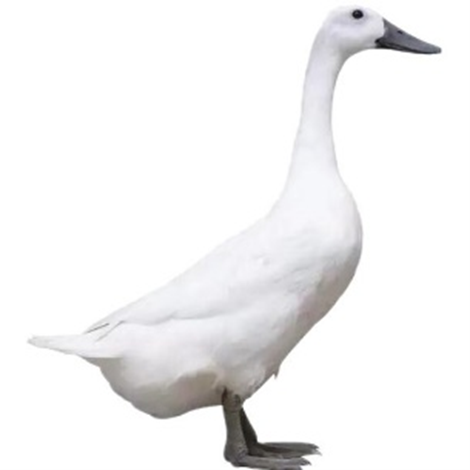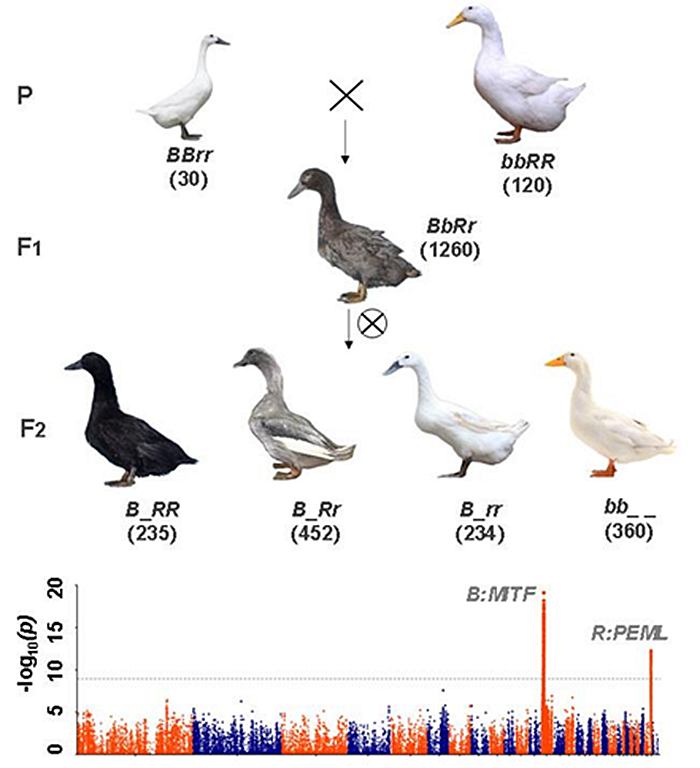The Genetic Mechanism Underlying the Formation of White Plumage in Liancheng Ducks
Recently, the Waterfowl Breeding and Nutrition Innovation Team of Institute of Animal Science, Chinese Academy of Agricultural Sciences (CAAS) has made new progress in the genetic mechanism of duck feather color formation. Their study revealed the genetic basis and molecular mechanism underlying the formation of the unique feather color and appearance phenotype of Liancheng Ducks. The related findings were published in GigaScience.

Figure 1 The Liancheng duck
The Liancheng Duck, also known as the Baiwu Duck or Black-beak duck, originates from Liancheng County in Longyan City, Fujian Province. Characterized by its distinctive "white feathers, black beak, and black feet", it is regarded as one of the most valuable duck breeds in China. Acclaimed as the " sole medicinal duck" and the "quintessence of Chinese ducks."
Feather and beak color are key phenotypic traits in meat ducks. Traditional culinary preferences favor ducks with pure white plumage and glossy black beaks and feet, making these characteristics essential in breeding high-quality meat ducks. The Liancheng Duck, with its distinctive white feathers, black beak, and webbed feet, represents an ideal genetic resource for developing superior meat duck strains. However, crossbreeding often results in offspring with unpredictable segregation of feather color and other morphological traits. Conventional breeding typically requires multiple generations of selection to achieve stable and uniform phenotypes. Moreover, for commercial production and intellectual property protection, all individuals must be homozygous to ensure breed purity and consistency.
Since 2017, the research team has collaborated with Shandong Rongda Agricultural Development Co., Ltd. to develop the "Zhongxu Rongda Meat Duck" breeding strain, using Liancheng Ducks and Pekin Ducks as parental lines. Phenotypic observations revealed that F1 hybrids displayed gray plumage, while the F2 generation segregated into four distinct feather color/appearance phenotypes. Notably, one phenotype perfectly matched the Liancheng Duck's characteristic white plumage with black beak and feet. Statistical analysis of the F2 population demonstrated a segregation ratio of 3:6:3:4, consistent with Mendelian dihybrid inheritance involving recessive epistasis—indicating that two interacting genes govern these traits.

Figure 2 GWAS Analysis of the Separated Populations and Morphological Traits of Liancheng and Pekin Ducks
(B represents the recessive dominant gene, R represents the incomplete dominant gene, and the numbers in parentheses indicate the population size)
To accurately identify the causal genes, the research team performed de novo assembly of a high-quality Liancheng Duck reference genome. Subsequent genome-wide association analysis (GWAS) of plumage color in the Liancheng Duck × Pekin Duck F2 population identified two distinct genetic loci: a recessive epistatic gene MITF on chromosome 13, and an incompletely dominant gene PMEL on chromosome 33. In 2018, the team successfully cloned and characterized the MITF gene, discovering a 6.6 kb insertion that completely disrupts the melanin synthesis transcript. This structural variation effectively silences the melanin biosynthesis pathway, resulting in the characteristic pure white plumage. The PMEL gene encodes a melanosome-specific structural protein essential for fibrillar matrix formation during melanin deposition. Functional analyses revealed two critical SNPs in PMEL that likely modulate transcriptional efficiency, thereby contributing to feather pigmentation variation.
Based on these genetic discoveries, the research team strategically developed a paternal line with the genotype bbrr (white feathers, yellow beak) and a maternal line with the genotype BBrr (white feathers, black beak). Through systematic crossing, they produced a commercial hybrid generation with the heterozygous genotype Bbrr, exhibiting the desired white plumage with black beak phenotype. This breeding strategy effectively protects the intellectual property rights of the "Zhongxu Rongda Meat Duck" breed and serves as a classic example of molecular breeding in the development of livestock and poultry cultivars.
The first author is Zhen Wang, a doctoral candidate at the Institute of Animal Science, CAAS. Professor Zhengkui Zhou serves as the corresponding author. This work was supported by the National Science Fund for Distinguished Young Scholars, the Innovation Program of CAAS, China Agriculture Research System of MOF and MARA, and the National Key Research and Development Program of China.
The full article can be accessed through the link: https://doi.org/10.1093/gigascience/giae114
-
 Jul 09, 2025CAAS President meets with WUR Executive Board Member
Jul 09, 2025CAAS President meets with WUR Executive Board Member -
 Jul 09, 2025CAAS President Meets with AAS President
Jul 09, 2025CAAS President Meets with AAS President -
 Jul 09, 2025Secretary of the Leadership Party Group of CAAS Meets with Secretary of the Brazilian Ministry of Agriculture and Livestock
Jul 09, 2025Secretary of the Leadership Party Group of CAAS Meets with Secretary of the Brazilian Ministry of Agriculture and Livestock -
 Jul 09, 2025CAAS Deepens Scientific Cooperation with IAEA
Jul 09, 2025CAAS Deepens Scientific Cooperation with IAEA -
Jul 09, 2025CAAS Deepens Agricultural Science and Technology Cooperation with Eastern European Countries
